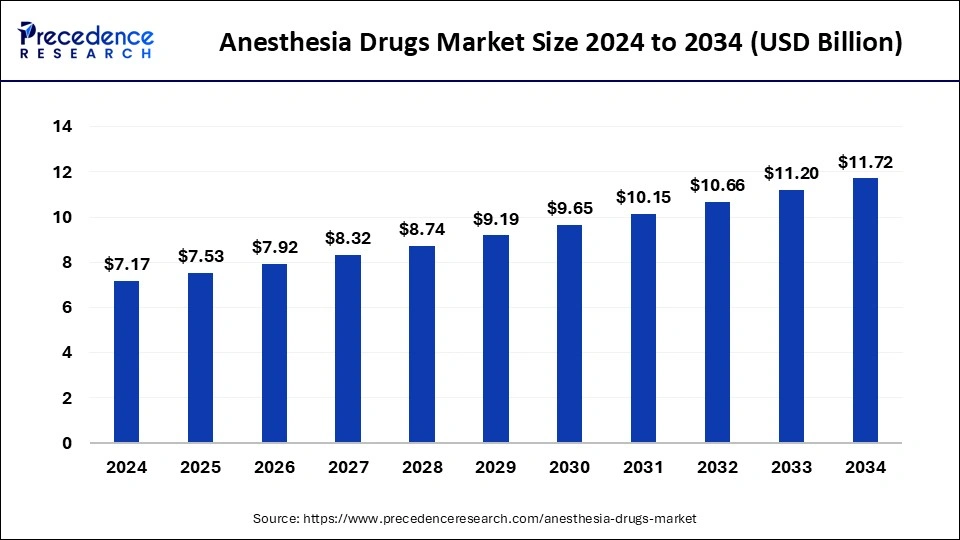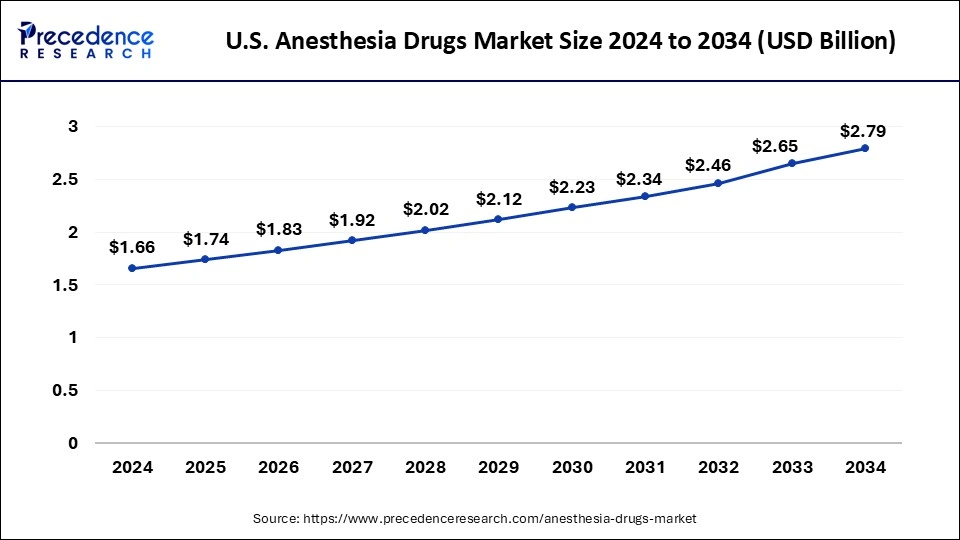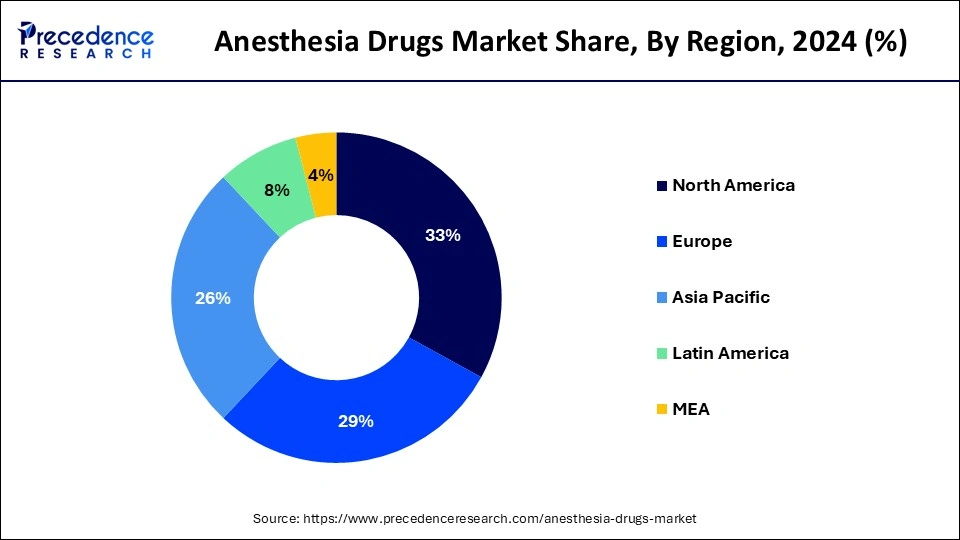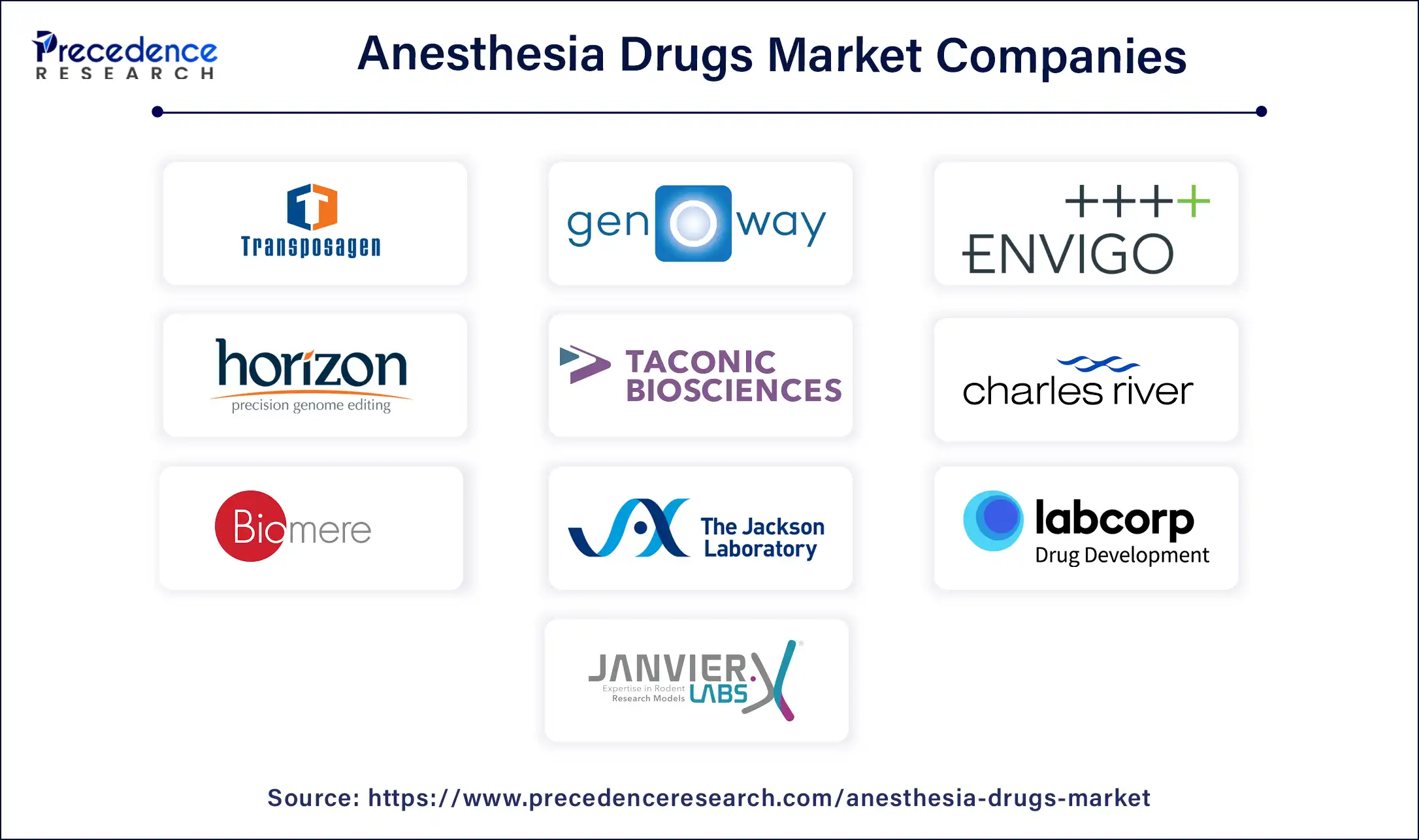February 2025
The global anesthesia drugs market size is calculated at USD 7.53 billion in 2025 and is forecasted to reach around USD 11.72 billion by 2034, accelerating at a CAGR of 5.04% from 2025 to 2034. The North America anesthesia drugs market size surpassed USD 2.37 billion in 2024 and is expanding at a CAGR of 5.03% during the forecast period. The market sizing and forecasts are revenue-based (USD Million/Billion), with 2024 as the base year.
The global anesthesia drugs market size was estimated at USD 7.17 billion in 2024 and is predicted to increase from USD 7.53 billion in 2025 to approximately USD 11.72 billion by 2034, expanding at a CAGR of 5.04% from 2025 to 2034. The rising number of approved new anesthesia drugs could boost the market.

The U.S. anesthesia drugs market size was exhibited at USD 1.66 billion in 2024 and is projected to be worth around USD 2.79 billion by 2034, poised to grow at a CAGR of 5.33% from 2025 to 2034.

North America dominated the anesthesia drugs market in 2024. North America boasts a fairly developed healthcare infrastructure, with well-established surgery centers, hospitals, and anesthetic supply networks, especially in the United States and Canada. This infrastructure supports the extensive use of anesthetic medications in a variety of medical contexts. Numerous surgical disciplines, including general surgery, orthopedics, cardiology, neurology, and cosmetic surgery, are performed often throughout North America.
The need for anesthetic medications is driven by the region's high surgical activity. The area is at the forefront of medical innovation and technology, with breakthroughs being made in pharmaceutical formulations, monitoring apparatuses, and anesthetic administration methods. The safety, effectiveness, and precision of anesthetic administration are improved by these technical developments, which support market leadership.

Asia Pacific is expected to host the fastest-growing anesthesia drugs market during the projected period. The area is seeing a large increase in investments made in updating and expanding its healthcare infrastructure. This involves the construction of new surgery centers, hospitals, and anesthesia facilities, all of which will increase the need for anesthetic medications.
The region is seeing a growing trend in the number of surgical interventions. The need for anesthetic medications is being driven by factors including increased surgery volume, urbanization, and greater access to healthcare services. Asia Pacific is going through demographic changes, such as an increase in the prevalence of chronic diseases and an aging population, much like other areas. The requirement for additional surgical procedures, including ones needing anesthetic drugs, is influenced by these variables.
The anesthesia drugs market refers to the drugs used to induce anesthesia, a controlled, transient loss of feeling or consciousness. These drugs are necessary for a number of medical procedures in order to ensure the comfort and lack of pain for the patients. There are two types of anesthesia drugs, namely, general anesthesia drugs and local anesthesia drugs. The market is driven by various factors, including rising incidence of chronic diseases, rising prevalence of dental issues, an increasing aging population, etc.
The anesthesia drugs market is fragmented with multiple small-scale and large-scale players, such as Taconic Biosciences Inc., Transpogen Biopharmaceutical, Inc., Charles River Laboratories International, Inc., The Jackson Laboratory, Laboratory Corporation of America Holdings, Perkin Elmer, Envigo, JANVIER LABS, Biomedical Research Models.
| Report Coverage | Details |
| Market Size by 2034 | USD 11.72 Billion |
| Market Size in 2025 | USD 7.53 Billion |
| Market Growth Rate from 2025 to 2034 | CAGR of 5.04% |
| Largest Market | North America |
| Base Year | 2024 |
| Forecast Period | 2025 to 2034 |
| Segments Covered | Type, Application, Route of Administration, and Regions |
| Regions Covered | North America, Europe, Asia-Pacific, Latin America, and Middle East & Africa |
Rising number of surgeries
The rising number of surgeries can boost the anesthesia drugs market. The range of anesthetic needed grows along with the quantity and diversity of procedures performed. A wider market for diverse anesthesia medications results from the possibility that different procedures will be needed for different anesthetic techniques (general, regional, or local anesthesia).
Aging population
The rising number of people in the aging population can boost the anesthesia drugs market. The aging of the world's population is contributing to an increase in the prevalence of age-related diseases such as knee replacements, heart procedures, and cataract operations, which frequently call for surgical intervention. This change in the population is a major factor contributing to the rise in operations and the resulting need for anesthetic medications.
High cost of anesthesia drug
The high cost of anesthesia drugs may slow down the anesthesia drugs market. The exorbitant prices may also act as a deterrent to new players entering the anesthesia medication business, which might prevent the development of novel and possibly more potent anesthetics. This may hinder market expansion and cause stagnation.
Reduction in the cost of newly invented anesthesia
The reduction in the cost of newly invented anesthesia can be the opportunity to grow the anesthesia drugs market. The reduced expenses can relieve hospitals' and clinics' financial strains, freeing up funds for other vital areas like patient care and infrastructure upgrades. This may raise patient happiness and overall service quality.
The general anesthetics segment dominated the anesthesia drugs market in 2024. The surgery, ranging from small outpatient treatments to more invasive operations, uses general anesthetics extensively. For several surgical procedures, they are indispensable as they have the capacity to incapacitate and render a patient unconscious fully. A safer and more advanced class of general anesthetic drugs has been introduced as a result of ongoing research.
The use of these more recent agents in a range of treatments is becoming increasingly appealing since they frequently have superior safety profiles, fewer side effects, and faster recovery periods. The increases in aging populations, the frequency of chronic illnesses needing surgical intervention, and improvements in surgical procedures have all contributed to a global rise in the number of operations done. A general anesthetic's need is directly increased by this increase in procedures.
The local anesthetics segment is expected to grow at the highest CAGR in the anesthesia drugs market during the forecast period. The minimally invasive operations and procedures which frequently need local anesthesia are becoming more and more popular. The need for local anesthetics is being driven by the fact that these treatments often have lower complications and quicker recovery times. Globally, the prevalence of chronic pain problems such as lower back pain and arthritis is rising.
Due to their widespread usage in pain management procedures like nerve blocks and injections, local anesthetics are helping the industry expand. There is a growing trend toward ambulatory and outpatient surgical centers, where treatments are frequently carried out under local anesthetic. The desire to lower healthcare expenses and increase patient comfort is what's driving this trend, which will help the local anesthetics industry.
The general surgery segment led the anesthesia drugs market in 2024. A wide variety of common treatments, including appendectomies, hernia repairs, gallbladder removals, and numerous abdominal surgeries, fall within the umbrella of general surgery. The need for anesthetic medications is mostly driven by the increased frequency of these operations.
Numerous procedures involving several bodily systems are included in general surgery. This variety guarantees a steady and strong market for various anesthetic medication classes, such as local, regional, and general anesthetics. Surgical treatments are frequently required due to the increasing incidence of chronic illnesses, including but not limited to obesity, gastrointestinal ailments, and cancer. These ailments fuel the demand for general surgical operations and the corresponding use of anesthetic medications.
The dental surgery segment is expected to grow at a rapid pace in the anesthesia drugs market during the forecast period. The need for dental surgery is being driven by the increased prevalence of dental issues such as tooth decay, periodontal disorders, and cavities. The need for dental anesthetic medications rises as more people seek treatment for these ailments. The significance of dental health and how it affects general health are becoming more well-recognized.
This has increased the need for anesthetic medications as more people seek out routine dental exams, procedures, and treatments. The number of dental operations conducted has grown as a result of advancements in methods, including the use of modern technologies and less invasive treatments. The need for dental anesthesia medications is fueled by the fact that these developments frequently call for efficient anesthetic treatment.
The intravenous anesthesia drugs segment held the dominant share of the anesthesia drugs market in 2024. In both small and large procedures, inhalation anesthetics are often employed. In a variety of surgical situations, they are especially valued for their ability to sustain anesthesia over lengthier operations.
A quick induction and recovery from anesthesia are made possible by inhalation anesthetics such as isoflurane, desflurane, and sevoflurane. Because it gives you more control over the anesthetic procedure, its rapid onset and offset are advantageous in both scheduled and emergency surgeries. The use of breathing medications makes adjusting the level of anesthesia simple. With a great degree of control and safety, anesthesiologists may quickly adjust the dosage to suit the patient's demands throughout surgery.
The inhalation anesthesia drugs segment is expected to grow at a significant rate in the anesthesia drugs market during the forecast period. The start of the effect of intravenous anesthetic medicines is often faster than those of other administration methods, such as inhalation anesthesia. IV medications are useful for a variety of surgical procedures because of their early onset, which facilitates the fast induction of anesthesia. The depth of anesthesia may be precisely controlled using IV anesthetic medications. Throughout the treatment, anesthesiologists can maintain ideal anesthetic levels by adjusting the dosage in accordance with the patient's response.
The likelihood of airway problems such as laryngospasm or bronchospasm is decreased by IV anesthetic medicines, in contrast to inhalation anesthesia, which necessitates airway care. This makes them the treatment of choice for patients whose airways are damaged or who are having difficult-to-control procedures. IV anesthetic medication usage is appropriate for both ambulatory and outpatient procedures.

By Type
By Application
By Route of Administration
By Geography
For inquiries regarding discounts, bulk purchases, or customization requests, please contact us at sales@precedenceresearch.com
No cookie-cutter, only authentic analysis – take the 1st step to become a Precedence Research client
February 2025
January 2025
January 2025
November 2024